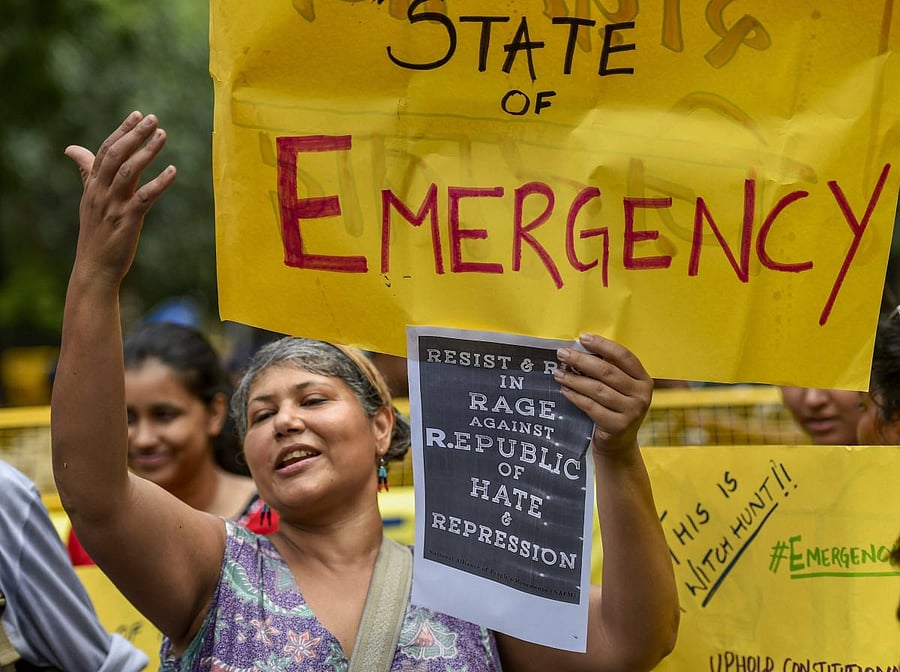
The arrest of intellectuals and social activists from different parts of India by the law enforcement agencies of Maharashtra has, once again, brought into focus the issue of ‘Urban Maoism’. On August 28, in a coordinated move, Maharashtra police arrested civil liberty/rights activists Sudha Bharadwaj, Gautam Navlakha, Vernon Gonsalves, Arun Ferreira and Varavara Rao on charges of having ‘strong links’ with the proscribed violent outfit, Communist Party of India-Maoists, or Maoists in short.
The arrests of the above mentioned were followed by coordinated raids on the residences of another set of activists, Father Stan Swamy, Susan Abraham and Anand Teltumbde. Along with the charges of having links with Maoists, these activists are also slapped with an allegation of a plot to kill the prime minister. These arrests and raids were preceded by an earlier set of arrests on June 6. Advocate Surendar Gadling, Prof Shoma Sen, writer Sudhir Dhawale, forest rights activist Mahesh Raut and prisoners’ rights activist Rona Wilson were arrested by Maharashtra police on charges of inciting the Bhima-Koregaon violence as well as on charges of plotting the assassination of the prime minister as a part of the larger Maoist strategy in urban centres.
While the law of the land will deal with the merit and legality of such charges slapped on intellectuals and social activists, the principal issue of ‘Urban Maoism’ needs to be critically engaged with. It is rather the distorted and limited understanding of the Maoists’ urban movement and the related amateurish actions that has led to the harsh criticism of successive governments’ handling of ‘Urban Maoism’.
Maoists’ Urban Movement
The urban movement of the Maoists is detailed in two party documents: Strategy and Tactics of Indian Revolution (STIR), 2004, and Urban Perspective: Our Work in Urban Areas (UPUA), 2007. Immediately after the merger of the People’s War Group (PWG) and the Maoist Communist Centre of India (MCCI) along with other fringe radical communist groups to form the CPI-Maoist in 2004, it was felt among the Maoist leadership that they needed a plan to have bases in urban centres.
The Maoists’ plan for an urban movement stems from a realisation of the blunders it committed during the Naxalbari phase of the movement. Blunders of defective understanding of urban specificities and warfare landed them in bloody confrontation with the security forces, which resulted in the killing of hundreds of its cadres and sympathisers. It was during this phase that the Maoists failed to garner much intellectual support which could have helped legitimise their movement.
Drawing from past experiences, in the Maoist scheme of things, the urban perspective plan has three broad objectives: mobilise and organise the basic masses and build the party in urban centres, including the creation of a ‘United Front’ and exploring its scope for military tasks. Just having a detailed plan for the urban movement doesn’t simply allow the Maoists to achieve their desired objectives.
Considering the well-entrenched democratic party system in the country, it is a rather herculean task for Maoists to dent the political ethos in Indian cities. Similarly, the presence of a strong administrative machinery and security forces limit the access to a suitable environment for the Maoists to carry out their operations in the urban centres. In short, the Maoists, so far, have not been able to make their presence felt in the urban centres.
Corroborating the Maoists’ limited and undeveloped presence in Indian urban centres, former union minister of state for home affairs RPN Singh deliberated on the floor of parliament on December 12, 2013 that ‘….However, till now, they have failed to make any significant headway in the urban areas of India primarily on account of the revulsion of the urban population towards mindless violence, torture, beheadings and other atrocities perpetrated by them on the civilian population and the security forces in their strongholds in Central India’. While the Maoists’ presence in urban areas is still confined to the party document, successive governments’ responses to this issue in terms of arresting intellectuals, activists and linking them with Maoists’ urban networks needs thorough examination.
Manufacturing Maoists
Labelling intellectuals and activists as ‘Urban Maoists’ is a manufactured narrative of successive governments in India. This cuts across political parties. Linking mass organisations, which are necessarily working for the under-privileged, with the Maoists has its root in the ‘Status Paper on the Naxal Problem’ presented on the floor of parliament by former union minister Shivraj Patil in 2006. Similarly, RPN Singh in 2013 reiterated, more specifically, how the Maoists are operating through ‘front organisations’ in and around urban areas.
In December 2012, the Government of India wrote to state governments highlighting 128 ‘front organisations’ of the Maoists. Many of the arrested activists mentioned above are linked to organisations appearing in the list of 128. The arrests of Kobad Ghandy, Binayak Sen and the like set the precedent for the recent arrests. Some of the activists and intellectuals arrested recently have had similar experiences in the past, too.
Successive governments have failed to distinguish between anti-government and anti-State activities. Further, the governments also fail to deal with Left-wing activists and extremists separately. After more than nine years of arrest of Kobad Ghandy, nothing has been proved against him. The government’s response in this regard has larger and deeper implications, which in many ways go against the State.
Governments, by linking intellectuals and activists with radical Maoists, serve the latter’s interests in two major ways. One, they legitimise the very presence of the Maoists and keep their discourse alive in the urban areas where, in reality, their presence have been menial and least threatening. The fight against Maoist radicals is a must, but manufacturing Maoists out of intellectuals and activists goes against the very democratic ethos of the Indian State and can actually aid in erroneously legitimising the Maoists’ reach into the urban centres.
(The writer is Assistant Professor, Conflict Resolution Programme, National Institute of Advanced Studies, Bengaluru)